北师大版(2019)选择性必修第四册Unit 10 Connections Lesson 1 How Closely Connected Are We?课件(共34张PPT,内镶嵌视频)
文档属性
| 名称 | 北师大版(2019)选择性必修第四册Unit 10 Connections Lesson 1 How Closely Connected Are We?课件(共34张PPT,内镶嵌视频) | 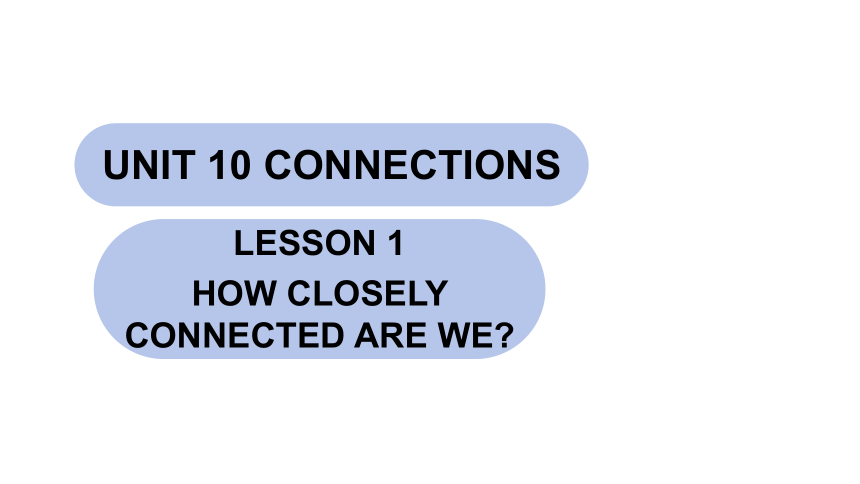 | |
| 格式 | pptx | ||
| 文件大小 | 18.3MB | ||
| 资源类型 | 教案 | ||
| 版本资源 | 北师大版(2019) | ||
| 科目 | 英语 | ||
| 更新时间 | 2025-04-01 18:40:57 | ||
图片预览

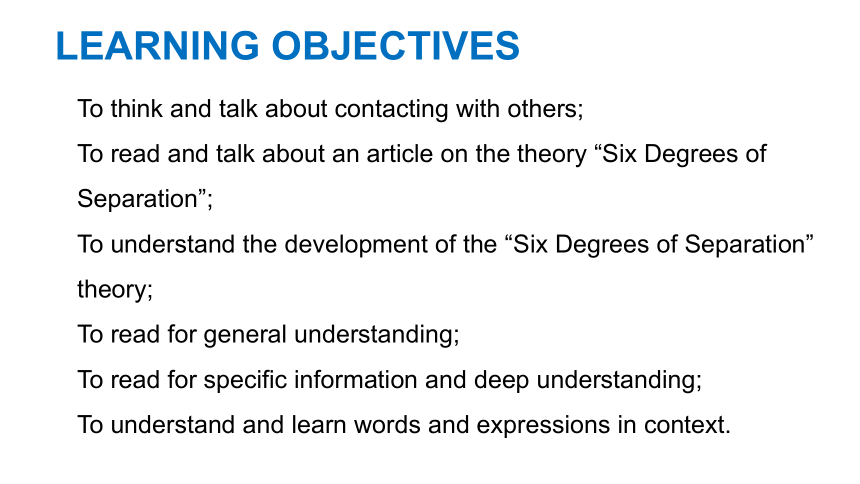
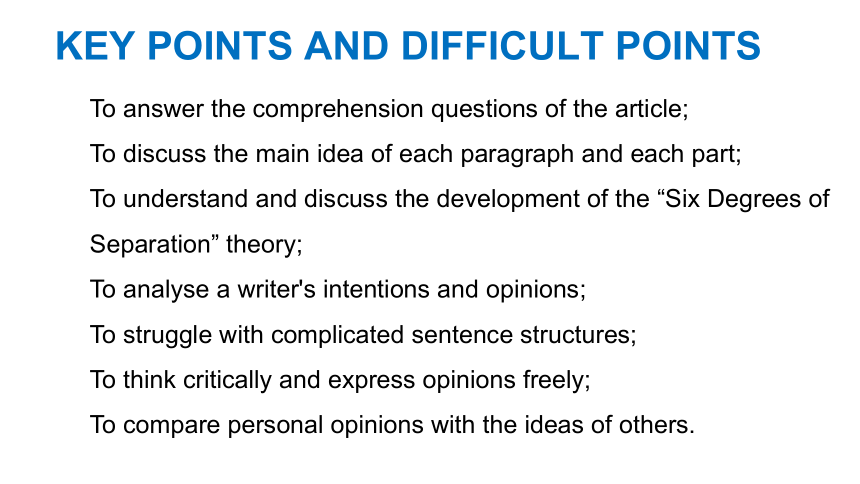

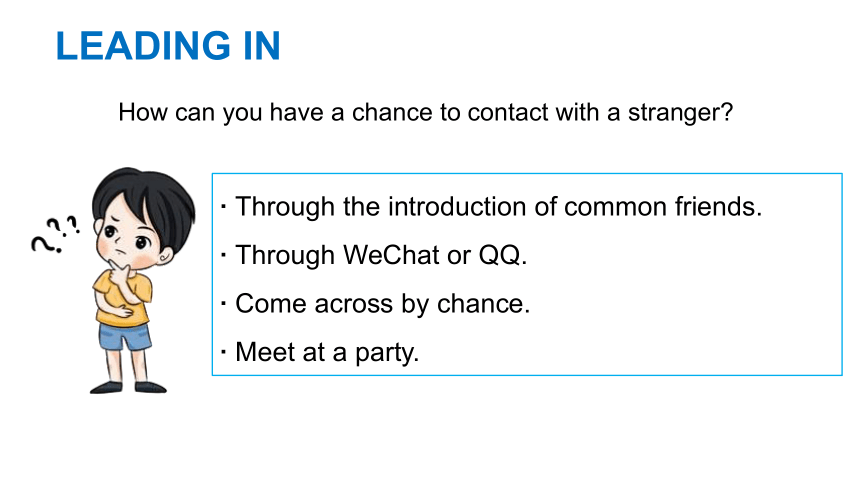
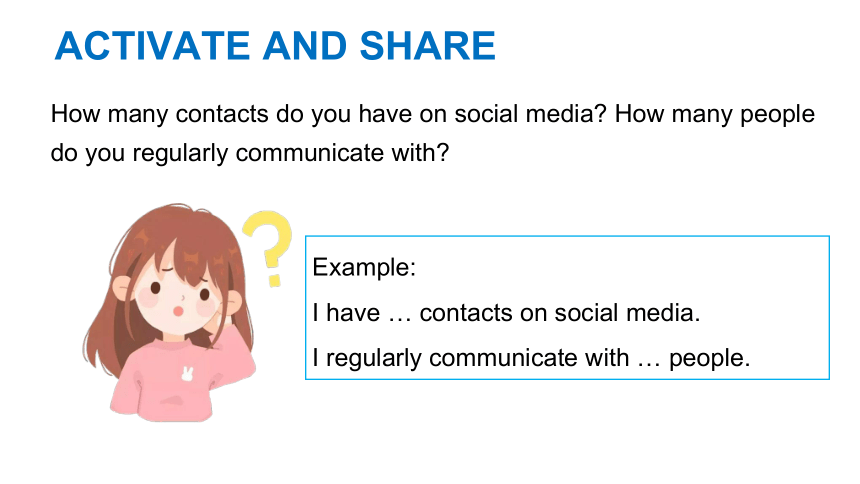
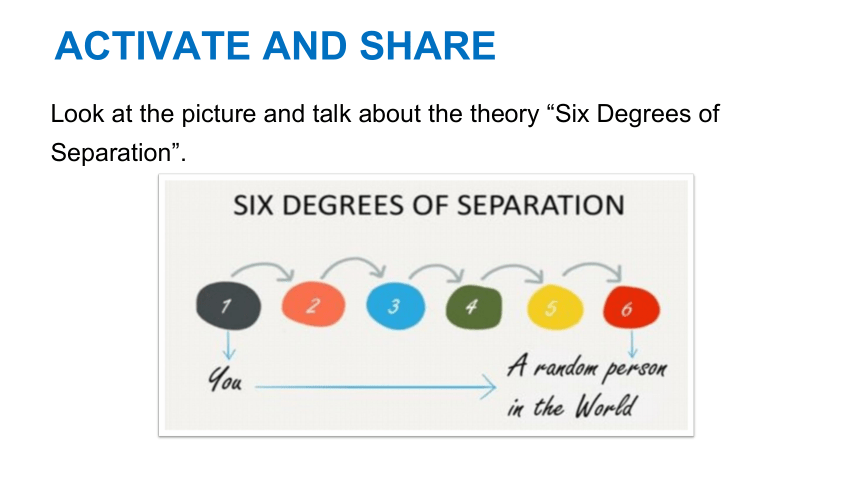
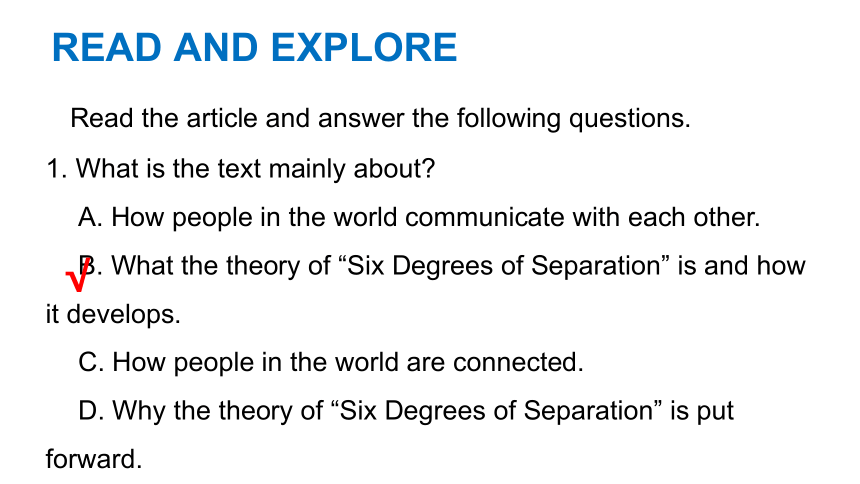
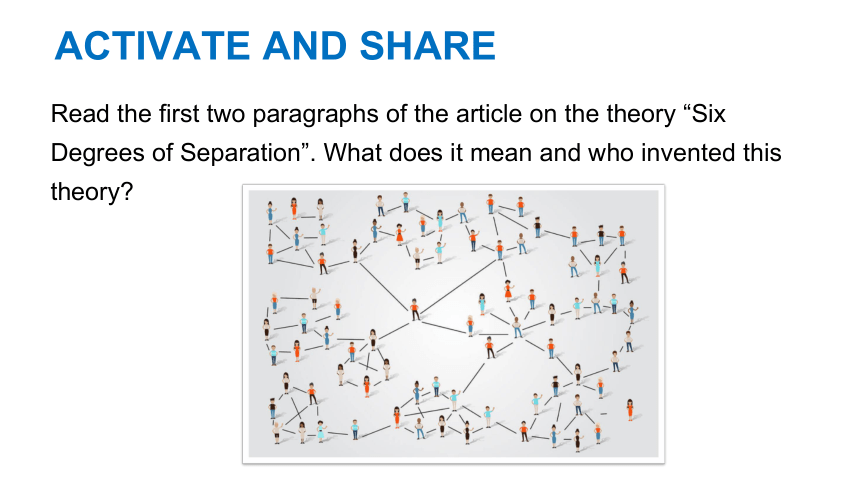
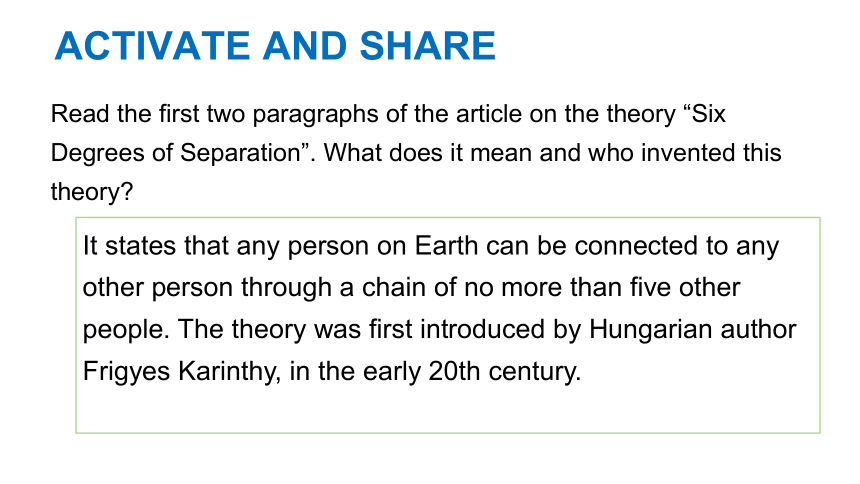
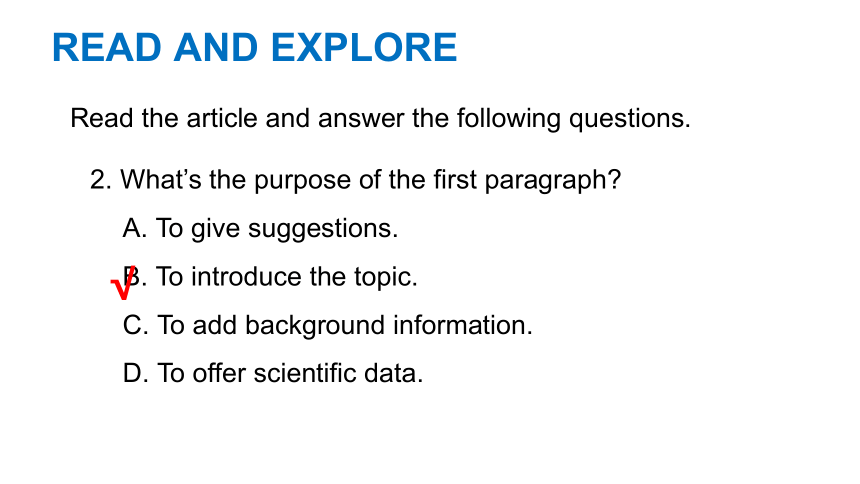

文档简介
(共34张PPT)
LESSON 1
HOW CLOSELY CONNECTED ARE WE
UNIT 10 CONNECTIONS
LEARNING OBJECTIVES
To think and talk about contacting with others;
To read and talk about an article on the theory “Six Degrees of Separation”;
To understand the development of the “Six Degrees of Separation” theory;
To read for general understanding;
To read for specific information and deep understanding;
To understand and learn words and expressions in context.
KEY POINTS AND DIFFICULT POINTS
To answer the comprehension questions of the article;
To discuss the main idea of each paragraph and each part;
To understand and discuss the development of the “Six Degrees of Separation” theory;
To analyse a writer's intentions and opinions;
To struggle with complicated sentence structures;
To think critically and express opinions freely;
To compare personal opinions with the ideas of others.
LEADING IN
How can you have a chance to contact with a stranger
· Through the introduction of common friends.
· Through WeChat or QQ.
· Come across by chance.
· Meet at a party.
ACTIVATE AND SHARE
How many contacts do you have on social media How many people do you regularly communicate with
Example:
I have … contacts on social media.
I regularly communicate with … people.
ACTIVATE AND SHARE
Look at the picture and talk about the theory “Six Degrees of Separation”.
READ AND EXPLORE
Read the article and answer the following questions.
1. What is the text mainly about
A. How people in the world communicate with each other.
B. What the theory of “Six Degrees of Separation” is and how it develops.
C. How people in the world are connected.
D. Why the theory of “Six Degrees of Separation” is put forward.
√
ACTIVATE AND SHARE
Read the first two paragraphs of the article on the theory “Six Degrees of Separation”. What does it mean and who invented this theory
ACTIVATE AND SHARE
Read the first two paragraphs of the article on the theory “Six Degrees of Separation”. What does it mean and who invented this theory
It states that any person on Earth can be connected to any other person through a chain of no more than five other people. The theory was first introduced by Hungarian author Frigyes Karinthy, in the early 20th century.
READ AND EXPLORE
Read the article and answer the following questions.
2. What’s the purpose of the first paragraph
A. To give suggestions.
B. To introduce the topic.
C. To add background information.
D. To offer scientific data.
√
ACTIVATE AND SHARE
Read the article and find out about the development of the “Six Degrees of Separation” theory. Take notes in the table below.
1967 Mid-1990s 2003 2011
Who How
Findings/ results
ACTIVATE AND SHARE
1967 Mid-1990s 2003 2011
Who
How
Findings/results
Stanley Milgram
Two college students in the United States
Columbia University
the University of Milan
He chose a random sample of people in the middle of America and asked them to send packages to a stranger in the state of Massachusetts.
The idea of the game was to link any actor to Kevin Bacon, a famous American actor and musician, through no more than six links.
The experiment involved 24,163 email chains with 18 target people in 13 different countries.
The experiment analysed the relationship between 721 million social media users.
It only took between five and seven people to get the parcels delivered.
The game was being played in universities across the United States.
The results confirmed that the average number of links in the chain was six.
92 percent were connected by only four stages, or five degrees of separation.
READ AND EXPLORE
Read the article and answer the following questions.
3. How did Stanley prove the theory
A. By asking a random sample of people to send parcels to the target stranger directly.
B. By asking a random sample of people to send parcels to the target stranger indirectly.
C. By choosing some certain people to send parcels directly.
D. By choosing some certain people to send parcels indirectly.
√
READ AND EXPLORE
Read the article and answer the following questions.
4. How did the author show the theory’s influence on the entertainment industry in this part
A. By giving examples.
B. By making comparisons.
C. By listing figures.
D. By providing the results of the experiment.
√
READ AND EXPLORE
Read the article and answer the following questions.
5. What do the two experiments have in common
A. They were both carried out on the Internet.
B. They were carried out in the same university.
C. Both of them were targeted at university students.
D. Both of them were referred to as “Columbia Small-world Project”.
√
READ AND EXPLORE
Read the article and answer the following questions.
6. Why does the writer ask the question in the last paragraph
A. To help readers recall the development of “Six Degrees of Separation”.
B. To make readers relate themselves to the theory of “Six Degrees of Separation”.
C. To persuade readers to agree with his/her opinions on the theory of “Six Degrees of Separation”.
D. To encourage readers to have a contact with others.
√
READ AND EXPLORE
Read the article and answer the following questions.
7. What’s the author’s purpose in writing the text
A. To tell us people in the world are closely connected with each other.
B. To persuade people to communicate with others in the world.
C. To indicate communication only happens between seven to fifteen people.
D. To prove people will seldom have a chance to meet a stranger.
√
READ AND EXPLORE
Group Work Read the article again. Take turns to explain the “Six Degrees of Separation” theory. Use the diagram to help you.
READ AND EXPLORE
What is the main idea of each paragraph
Para 1
What does “Six Degrees of Separation” refer to
Para 2
Who invented the theory
Para 3
Stanley Milgram tested the theory successfully.
Para 4
How did the theory influence the entertainment industry
Para 5
The result of Columbia University’s study.
Para 6
The result of the University of Milan’s study.
Para 7
How closely connected are you
READ AND EXPLORE
Match main ideas of each part.
Part 1
(Paras.1-2)
Part 2
(Paras.3-6)
Part 3
(Para.7)
Introduction of the theory
Development of the theory
Emphasis of the theory
READ AND EXPLORE
In the mid-1990s
How Closely Connected Are We
In 1967
In 2011
In 2003
Examples to prove the theory
Introduction
Conclusion
The theory “Six Degrees of Separation” was first talked about in the 1920s.
People are closely connected.
A person can be connected to anyone through no more than five other people according to the theory.
READ AND EXPLORE
1. Why did Milgram and Columbia University both label their experiments “Small-world”
Group Work Think and share
Because they believed that any person on Earth could be connected to any other person through a chain of no more than five other people. In this sense the world is small.
READ AND EXPLORE
2. Why do you think people study how people are connected
Group Work Think and share
Probably people want to study the structures of human society, the rules of human social activities, and how people are connected with each other.
READ AND EXPLORE
Complete the sentences with the correct form of the words.
1. In 1967, _____________ Stanley Milgram did an experiment to find out how many degrees of separation there were between strangers in different parts of America.
2. All of the _____________ in Milgram’s experiment were delivered to the right people after passing through the hands of between five and seven people.
random sociologist network publish package chain
sociologist
packages
READ AND EXPLORE
Complete the sentences with the correct form of the words.
3. The results of Milgram’s experiment ___________________ in the magazine Psychology Today.
4. The results of the “Columbia Small-world Project” confirmed that the average number of links in the _____________ was six.
random sociologist network publish package chain
were published
chain
READ AND EXPLORE
Complete the sentences with the correct form of the words.
5. People doing experiments into “Six Degrees of Separation” usually choose a _____________ sample of people to take part to make the results more reliable.
6. Recently, creating and growing your social _____________ has become more important than ever before due to the growth of social media.
random sociologist network publish package chain
random
network
EXPRESS YOURSELF
Search online and find details about the "small-worid problem" “Columbia Small-worid Project" or other experiments related to the theory. Write a short report on your findings.
VOCABULARY
1. impression
get/have a good/bad impression of 对……的印象好/不好
leave/make a(n)...impression on sb. 给某人留下……的印象
impress v. 使留下深刻印象;使意识到(重要性或严肃性等)
impress sb. with sth. 某事物给某人留下深刻印象
impress sth. on sb. 使某人意识到某事的重要性
be impressed with/ by 对……印象深刻
练习:The scenery left a deep ______________ on us.
impression
VOCABULARY
2. random
a random sample/ selection 随机抽样/选择
arrange...in a random order 随机排列……
at random 胡乱地;随便地;任意地
choose/ select/ pick...at random 随意选择……
randomly adv. 随便地,任意地;无目的地,胡乱地;未计划地
练习:He went into a grocery and picked some snacks from the shelf at ______________.
random
VOCABULARY
3. It takes... to do sth.
spend some time/money on sth. 在某事物上花一些时间/ 钱
spend some time/money doing sth. 花一些时间/ 金钱做某事
pay some money for sth. 花一些钱买某物
sth. cost sb. some money 某物花某人一些钱
练习:It ______________ him about thirty minutes to have his parcel delivered in the post office.
took
PRACTICE
1. You'll have to play better than that if you really want to make an ____________________ (impress).
2. In her study, participants were __________________ (random) assigned to two groups.
3. British schools are now required by law to __________________ (publish) their exam results.
4. Time how long it takes ______________ (take) you to answer the questions.
impression
randomly
publish
takes
SUMMARY
Read and talk about an article on the theory “Six Degrees of Separation”;
Understand the development of the “Six Degrees of Separation” theory;
Discuss the main idea of each paragraph and each part;
Answer the comprehension questions of the article;
Understand and learn words and expressions in context;
Think critically and express opinions freely.
Thank you
LESSON 1
HOW CLOSELY CONNECTED ARE WE
UNIT 10 CONNECTIONS
LEARNING OBJECTIVES
To think and talk about contacting with others;
To read and talk about an article on the theory “Six Degrees of Separation”;
To understand the development of the “Six Degrees of Separation” theory;
To read for general understanding;
To read for specific information and deep understanding;
To understand and learn words and expressions in context.
KEY POINTS AND DIFFICULT POINTS
To answer the comprehension questions of the article;
To discuss the main idea of each paragraph and each part;
To understand and discuss the development of the “Six Degrees of Separation” theory;
To analyse a writer's intentions and opinions;
To struggle with complicated sentence structures;
To think critically and express opinions freely;
To compare personal opinions with the ideas of others.
LEADING IN
How can you have a chance to contact with a stranger
· Through the introduction of common friends.
· Through WeChat or QQ.
· Come across by chance.
· Meet at a party.
ACTIVATE AND SHARE
How many contacts do you have on social media How many people do you regularly communicate with
Example:
I have … contacts on social media.
I regularly communicate with … people.
ACTIVATE AND SHARE
Look at the picture and talk about the theory “Six Degrees of Separation”.
READ AND EXPLORE
Read the article and answer the following questions.
1. What is the text mainly about
A. How people in the world communicate with each other.
B. What the theory of “Six Degrees of Separation” is and how it develops.
C. How people in the world are connected.
D. Why the theory of “Six Degrees of Separation” is put forward.
√
ACTIVATE AND SHARE
Read the first two paragraphs of the article on the theory “Six Degrees of Separation”. What does it mean and who invented this theory
ACTIVATE AND SHARE
Read the first two paragraphs of the article on the theory “Six Degrees of Separation”. What does it mean and who invented this theory
It states that any person on Earth can be connected to any other person through a chain of no more than five other people. The theory was first introduced by Hungarian author Frigyes Karinthy, in the early 20th century.
READ AND EXPLORE
Read the article and answer the following questions.
2. What’s the purpose of the first paragraph
A. To give suggestions.
B. To introduce the topic.
C. To add background information.
D. To offer scientific data.
√
ACTIVATE AND SHARE
Read the article and find out about the development of the “Six Degrees of Separation” theory. Take notes in the table below.
1967 Mid-1990s 2003 2011
Who How
Findings/ results
ACTIVATE AND SHARE
1967 Mid-1990s 2003 2011
Who
How
Findings/results
Stanley Milgram
Two college students in the United States
Columbia University
the University of Milan
He chose a random sample of people in the middle of America and asked them to send packages to a stranger in the state of Massachusetts.
The idea of the game was to link any actor to Kevin Bacon, a famous American actor and musician, through no more than six links.
The experiment involved 24,163 email chains with 18 target people in 13 different countries.
The experiment analysed the relationship between 721 million social media users.
It only took between five and seven people to get the parcels delivered.
The game was being played in universities across the United States.
The results confirmed that the average number of links in the chain was six.
92 percent were connected by only four stages, or five degrees of separation.
READ AND EXPLORE
Read the article and answer the following questions.
3. How did Stanley prove the theory
A. By asking a random sample of people to send parcels to the target stranger directly.
B. By asking a random sample of people to send parcels to the target stranger indirectly.
C. By choosing some certain people to send parcels directly.
D. By choosing some certain people to send parcels indirectly.
√
READ AND EXPLORE
Read the article and answer the following questions.
4. How did the author show the theory’s influence on the entertainment industry in this part
A. By giving examples.
B. By making comparisons.
C. By listing figures.
D. By providing the results of the experiment.
√
READ AND EXPLORE
Read the article and answer the following questions.
5. What do the two experiments have in common
A. They were both carried out on the Internet.
B. They were carried out in the same university.
C. Both of them were targeted at university students.
D. Both of them were referred to as “Columbia Small-world Project”.
√
READ AND EXPLORE
Read the article and answer the following questions.
6. Why does the writer ask the question in the last paragraph
A. To help readers recall the development of “Six Degrees of Separation”.
B. To make readers relate themselves to the theory of “Six Degrees of Separation”.
C. To persuade readers to agree with his/her opinions on the theory of “Six Degrees of Separation”.
D. To encourage readers to have a contact with others.
√
READ AND EXPLORE
Read the article and answer the following questions.
7. What’s the author’s purpose in writing the text
A. To tell us people in the world are closely connected with each other.
B. To persuade people to communicate with others in the world.
C. To indicate communication only happens between seven to fifteen people.
D. To prove people will seldom have a chance to meet a stranger.
√
READ AND EXPLORE
Group Work Read the article again. Take turns to explain the “Six Degrees of Separation” theory. Use the diagram to help you.
READ AND EXPLORE
What is the main idea of each paragraph
Para 1
What does “Six Degrees of Separation” refer to
Para 2
Who invented the theory
Para 3
Stanley Milgram tested the theory successfully.
Para 4
How did the theory influence the entertainment industry
Para 5
The result of Columbia University’s study.
Para 6
The result of the University of Milan’s study.
Para 7
How closely connected are you
READ AND EXPLORE
Match main ideas of each part.
Part 1
(Paras.1-2)
Part 2
(Paras.3-6)
Part 3
(Para.7)
Introduction of the theory
Development of the theory
Emphasis of the theory
READ AND EXPLORE
In the mid-1990s
How Closely Connected Are We
In 1967
In 2011
In 2003
Examples to prove the theory
Introduction
Conclusion
The theory “Six Degrees of Separation” was first talked about in the 1920s.
People are closely connected.
A person can be connected to anyone through no more than five other people according to the theory.
READ AND EXPLORE
1. Why did Milgram and Columbia University both label their experiments “Small-world”
Group Work Think and share
Because they believed that any person on Earth could be connected to any other person through a chain of no more than five other people. In this sense the world is small.
READ AND EXPLORE
2. Why do you think people study how people are connected
Group Work Think and share
Probably people want to study the structures of human society, the rules of human social activities, and how people are connected with each other.
READ AND EXPLORE
Complete the sentences with the correct form of the words.
1. In 1967, _____________ Stanley Milgram did an experiment to find out how many degrees of separation there were between strangers in different parts of America.
2. All of the _____________ in Milgram’s experiment were delivered to the right people after passing through the hands of between five and seven people.
random sociologist network publish package chain
sociologist
packages
READ AND EXPLORE
Complete the sentences with the correct form of the words.
3. The results of Milgram’s experiment ___________________ in the magazine Psychology Today.
4. The results of the “Columbia Small-world Project” confirmed that the average number of links in the _____________ was six.
random sociologist network publish package chain
were published
chain
READ AND EXPLORE
Complete the sentences with the correct form of the words.
5. People doing experiments into “Six Degrees of Separation” usually choose a _____________ sample of people to take part to make the results more reliable.
6. Recently, creating and growing your social _____________ has become more important than ever before due to the growth of social media.
random sociologist network publish package chain
random
network
EXPRESS YOURSELF
Search online and find details about the "small-worid problem" “Columbia Small-worid Project" or other experiments related to the theory. Write a short report on your findings.
VOCABULARY
1. impression
get/have a good/bad impression of 对……的印象好/不好
leave/make a(n)...impression on sb. 给某人留下……的印象
impress v. 使留下深刻印象;使意识到(重要性或严肃性等)
impress sb. with sth. 某事物给某人留下深刻印象
impress sth. on sb. 使某人意识到某事的重要性
be impressed with/ by 对……印象深刻
练习:The scenery left a deep ______________ on us.
impression
VOCABULARY
2. random
a random sample/ selection 随机抽样/选择
arrange...in a random order 随机排列……
at random 胡乱地;随便地;任意地
choose/ select/ pick...at random 随意选择……
randomly adv. 随便地,任意地;无目的地,胡乱地;未计划地
练习:He went into a grocery and picked some snacks from the shelf at ______________.
random
VOCABULARY
3. It takes... to do sth.
spend some time/money on sth. 在某事物上花一些时间/ 钱
spend some time/money doing sth. 花一些时间/ 金钱做某事
pay some money for sth. 花一些钱买某物
sth. cost sb. some money 某物花某人一些钱
练习:It ______________ him about thirty minutes to have his parcel delivered in the post office.
took
PRACTICE
1. You'll have to play better than that if you really want to make an ____________________ (impress).
2. In her study, participants were __________________ (random) assigned to two groups.
3. British schools are now required by law to __________________ (publish) their exam results.
4. Time how long it takes ______________ (take) you to answer the questions.
impression
randomly
publish
takes
SUMMARY
Read and talk about an article on the theory “Six Degrees of Separation”;
Understand the development of the “Six Degrees of Separation” theory;
Discuss the main idea of each paragraph and each part;
Answer the comprehension questions of the article;
Understand and learn words and expressions in context;
Think critically and express opinions freely.
Thank you
同课章节目录
- Unit 10 Connections
- Lesson 1 How Closely Connected Are We?
- Lesson 2 Community Spirit
- Lesson 3 Anne of Green Gables
- Unit 11 Conflict And Compromise
- Lesson 1 Living In a Community
- Lesson 2 Dealing with Conflict
- Lesson 3 War Memories
- Unit 12 Innovation
- Lesson 1 Scientific Breakthroughs
- Lesson 2 Aha Moment
- Lesson 3 Stephen Hawking
